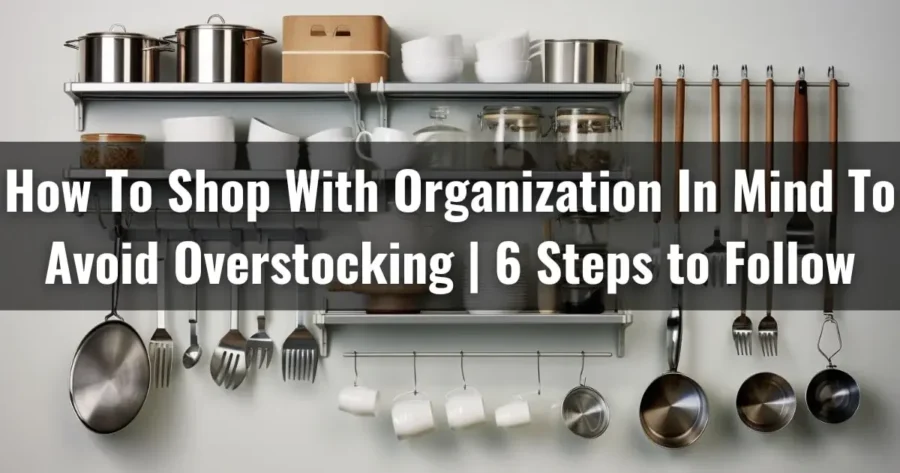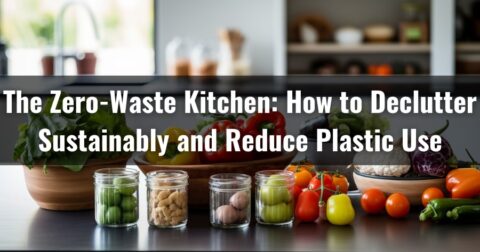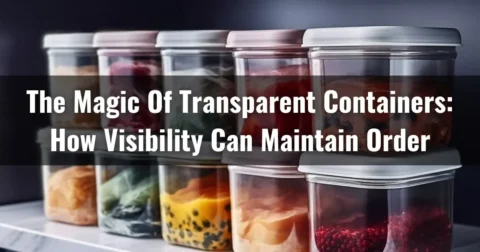Many people struggle with keeping their kitchen organized, leading to overstocking and unnecessary spending. But the good news is that you can avoid overstocking and keep your kitchen organized and efficient with strategic shopping.
Use inventory management principles to avoid overstock inventory in your kitchen, by categorizing essential kitchen items based on their usage frequency or type. Categorize items based on organization principles when creating a shopping list. Also, focus on the quality and functionality of items to avoid overstocking and save money in the long run.
With this article, we will share six steps for shopping with an organization in mind to prevent overstocking. So, don’t waste more time searching for your favorite spatula or the elusive spice jar. Keep reading and get organized today.
Jump to Section
Smart Shopping for an Organized Kitchen: 6 Steps to Avoid Overstocking
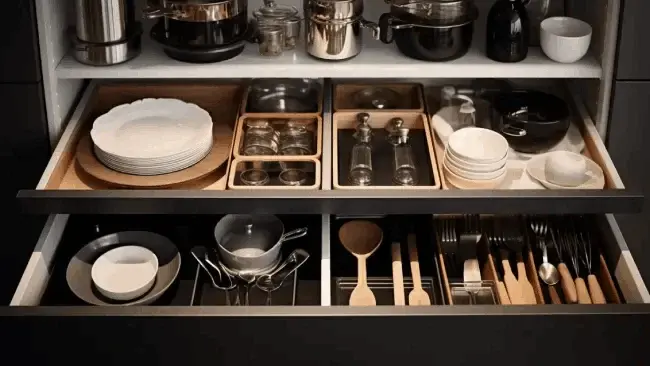
A clutter-free kitchen with well-managed inventory levels enhances efficiency and creates a serene cooking environment. Before heading out for necessary kitchen items, follow these six steps to shop smart and keep your kitchen organized:
- Analyze what you currently have
- Analyze your usage patterns for kitchen items
- Create an organized shopping list
- Prioritize quality over quantity
- Stick to your budget and avoid impulse buys
Step 1: Analyze What You Currently Have
Find out what kitchen supplies you already have by taking a stock count. This is crucial to avoid overstocking and wasting money on unnecessary purchases.
Start by auditing your cabinets, drawers, and pantry to identify items you may already have in surplus. Look for duplicates or items that you rarely use. Consider the condition and functionality of each item to determine if it’s worth keeping or if it’s time to replace it.
Step 2: Analyze Your Usage Patterns for Kitchen Items
To shop for kitchen items, consider analyzing your kitchen items usage patterns. Look at how you use your kitchen space and group items based on their usage or type. This will help you prioritize what you need to buy and what you can skip.
For example, if you notice that you rarely use certain utensils, you can avoid purchasing duplicates or unnecessary gadgets. Understanding your usage patterns allows you to make smarter choices and prevents the accumulation of unnecessary items.
Step 3: Create an Organized Shopping List
When creating your shopping list, it’s important to consider your usage patterns and categorize items based on kitchen organization principles. Grouping items together will help you stay focused and avoid impulsive purchases that can lead to overstocking.
Start by assessing your needs for storage containers, such as food storage bags, plastic containers, and glass jars. Consider adding organizational tools like drawer dividers, shelf organizers, and spice racks to keep your kitchen tidy.
Don’t forget to include essential cleaning supplies like dish soap, sponges, and microfiber cloths. Consider any items you need for meal preparation, such as cutting boards, knives, and measuring cups.
Step 4: Prioritize Quality Over Quantity
When creating your organized shopping list for a clutter-free kitchen, prioritize quality over quantity to avoid overstocking. Resist the urge to buy in bulk because it seems like a good deal. Instead, focus on the quality and efficiency of your purchasing items.
Investing in durable and versatile kitchen items that align with your cooking and storage needs will save you from clutter and unnecessary expenses in the long run. Consider the materials used, the brand’s reputation, and the reviews from other users to ensure you’re getting last-worthy items.
Step 5: Stick to Your Budget and Avoid Impulse Buys
Stick to your budget and resist the temptation to make impulse purchases when shopping for kitchen items with organization in mind. It’s easy to get carried away and buy things you don’t need, leading to overstocking and clutter in your kitchen.
Before making a purchase, ask yourself if the item is a necessity or if it aligns with your organized kitchen goals. Consider whether you already have something similar or can repurpose your own item.
By adhering to your budget and avoiding impulsive decisions, you’ll maintain better control over your kitchen inventory and prevent unnecessary clutter.
Why Should You Avoid Overstocking When Shopping for Kitchen Items?

Overstocking or accumulating surplus items can undermine your efforts to maintain an organized and efficient kitchen. When shopping for kitchen items, avoiding overstocking is important for several reasons.
1. Space Efficiency and Storage Costs
To maximize the efficiency of your kitchen space and minimize storage costs, it’s essential to avoid overstocking with kitchen items.
Overstocking leads to cluttered cabinets, drawers, and countertops, making it difficult to find and access the needed items. This not only hampers your productivity in the kitchen but also creates a visually unappealing environment.
Additionally, surplus items take up valuable storage space, increasing storage costs. By being mindful of your purchases and avoiding overstocking, you ensure that every inch of your kitchen is utilized purposefully.
2. Maintaining Kitchen Organization
You should reduce the unnecessary items in your kitchen to maintain organization and prevent clutter. Overstocking leads to a lack of space, making it difficult to find what you need when you need it. It increases the chances of items getting lost or forgotten, wasting money and time.
By avoiding overstocking, you can keep your kitchen neat, making it easier to navigate and work efficiently. It also gives you a clear view of what you have, preventing duplicate purchases and unnecessary spending.
Instead of buying in bulk or stocking up on items you rarely use, focus on purchasing only what you need in the immediate future. This practice will help maintain a well-organized kitchen and create a more functional cooking space.
3. Preventing Product Expiration
Avoid overstocking your kitchen with unnecessary items to prevent product expiration and unnecessary wastage. Surplus stock increases the risk of items reaching their expiration date and becoming unusable. When items sit in the back of cabinets for too long, they may need to be heavily discounted or thrown away.
Avoiding overstocking ensures that your kitchen remains stocked with fresh and usable items. This reduces the likelihood of wastage and saves you from unnecessary expenditures. Keeping a well-organized kitchen allows you to easily keep track of expiration dates and use items before they go bad.
4. Enhancing Sustainability
When you avoid overstocking your kitchen with unnecessary items, you enhance sustainability in your kitchen ecosystem. By prioritizing quality over quantity and only purchasing what you truly need, you reduce unnecessary waste and minimize your environmental impact.
Overstocking often leads to food spoilage and expiration, resulting in food waste that contributes to greenhouse gas emissions. Buying excessive kitchen items means more resources are used in production, packaging, and transportation, further depleting natural resources and contributing to pollution.
5. Preserving Cash Flow
By prioritizing organization and limiting overstocking, you can effectively preserve your cash flow when shopping for kitchen items.
Overstocked goods can tie up your cash, preventing you from investing in new and necessary items. When you have excess inventory on your shelves, your money is essentially locked away and unable to be used for other important purposes.
Avoiding overstocking frees up your cash flow, giving you the flexibility to invest in high-quality, essential kitchen items that truly enhance your cooking experience. By carefully planning your purchases and only buying what you need, you can ensure your money is used wisely and efficiently.
FAQ’s: Avoid Overstocking Kitchen Inventory
How do I organize my kitchen logically?
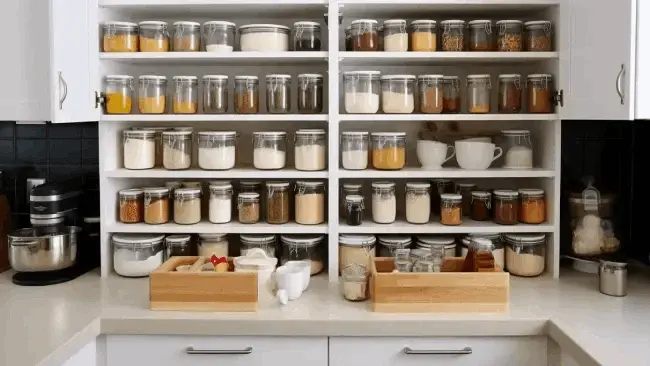
Start by grouping items based on their function and proximity to where they’re commonly used. Keep cooking and baking pieces close to your food preparation area, making them accessible when needed.
Utensils should be stored in the drawer nearest the prep area for convenience. Glassware is best kept near the sink or refrigerator for easy access when serving drinks or storing leftovers.
Consider creating a dedicated coffee or tea station near a water source. This station should include essentials like sugar, mugs, and filters.
How can I improve my kitchen organizational skills?
To improve your kitchen organizational skills, start by evaluating your current storage space and identifying areas for improvement.
Look at your drawers, cabinets, and pantry to see if there are any wasted spaces or inefficiencies. Consider using storage containers or dividers to maximize your available space. Keep similar items together and designate specific areas for different categories, such as baking supplies, cooking utensils, and spices.
Another helpful tip is to declutter your kitchen regularly by removing items you no longer use or need. Adopting a ‘One In, One Out’ system for perishables can also help prevent overcrowding and food waste.
Conclusion
Shopping smartly for kitchen items and avoiding overstocking is about organization and self-awareness. By following these steps, you can build the ultimate kitchen that is both functional and clutter-free.
Start with a thorough analysis of your current kitchen items, analyze your usage patterns, create an organized shopping list, prioritize quality over quantity, stick to your budget, and avoid impulse buys.
By doing so, you’ll end up with a more organized and functional kitchen that will improve your overall quality of life. So, next time you go shopping, remember these tips to avoid overstocking and clutter.


